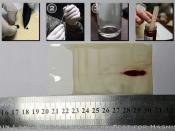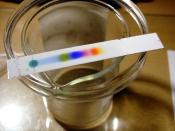Introduction: This experiment involves an extraction of a natural product using the techniques of steam distillation. The principle component of oil of cloves is an aromatic compound, which is identified by thin layer chromatography (TLC).
Eugenol is widely used in dentistry, due to its analgesic, antiseptic balsamic qualities. It is ideal for curative for pulp hyperemia (the soft, sensitive substance underneath the enamel and dentine of a tooth) and pulp its. In dentistry eugenol is also used to cover cavities, fill canals, etc. It also keeps food fresh and kills off bacteria and viruses. Eugenol helps keep meat fresh and prevents stomach upset, diarrhea, and wound infections. In addition, it might play a part in relieving indigestion, controlling diarrhea, and healing cuts and bites.
Eugenol is the main active ingredient in cloves.
Procedure:
1. In a 250 mL round bottom flask, place 10.0g of ground cloves and 80 mL of water.
Set up for a simple distillation
2. Heat to boiling and collect the distillate until you no longer see droplets of organic liquid coming out of the condenser (about 40 minutes).
3. Place the distillate in a separatory funnel and extract with three 10 mL portions of Dichloromethane
4. Combine the dichloromethane extracts and dry over Sodium Sulfate.
5. Examine the purity of the extract using thin-layer chromatography (TLC). Spot a small sample of the extract using a capillary spotter about 1 cm from the end of TLC plate.
6. Visualize using a UV light and mark the visualized spots with a pencil.
7. Record the number of spots and the Rf values from the spot(s).
8. While the plate is developing set up a clean and dry distillation set up and distil off most of the dichloromethane solvent.
9. The remaining solution of Eugenol in Dichloromethane can...


